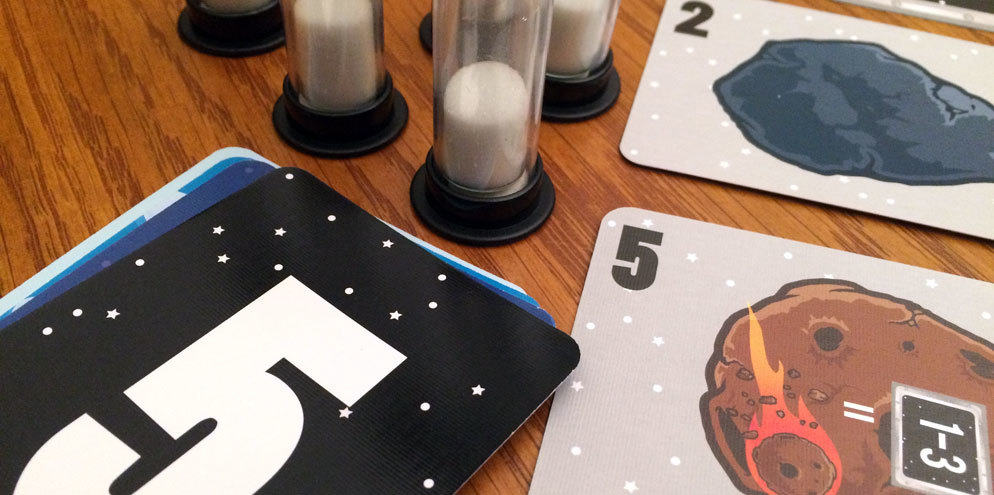 The first time I was introduced to a real-time mechanic in a board game was when I played Space Alert. Despite the group being awful at safely flying a spaceship our first few times through, I was enamored with the mechanic. I loved how you could get a full experience of a game in ten minutes, without the slowdown that occurred while players decided what they were going to do on their turn.
The first time I was introduced to a real-time mechanic in a board game was when I played Space Alert. Despite the group being awful at safely flying a spaceship our first few times through, I was enamored with the mechanic. I loved how you could get a full experience of a game in ten minutes, without the slowdown that occurred while players decided what they were going to do on their turn.
Today we will be examining Meteor, in which players work together to build rockets to destroy incoming meteors that are hurling towards Earth to destroy humanity… in just five minutes! Let’s get into the review to see if this is a game that you would like to add to your collection.
Meteor is a cooperative, real-time card game for 1-6 players that takes about 5 minutes to play. Meteor works best with four players.
Game Overview:
Apparently, all government space agencies around the world were taking a coffee break for a few years and didn’t notice that the Earth was going to be in the direct path of a group of asteroids. Now that the asteroids have entered our atmosphere, it’s up to the players to save humanity.
Everyone will have to work together to build and launch rockets, develop technology to gain the upper hand, and retrofit unusable resources to stop these impending impacts. Players will need to destroy all of the meteors before the five minutes are up or else they lose the game. This might seem simple; but the time constraint isn’t the only issue. Players are also not able to speak to each other at the start of the game.
Components:
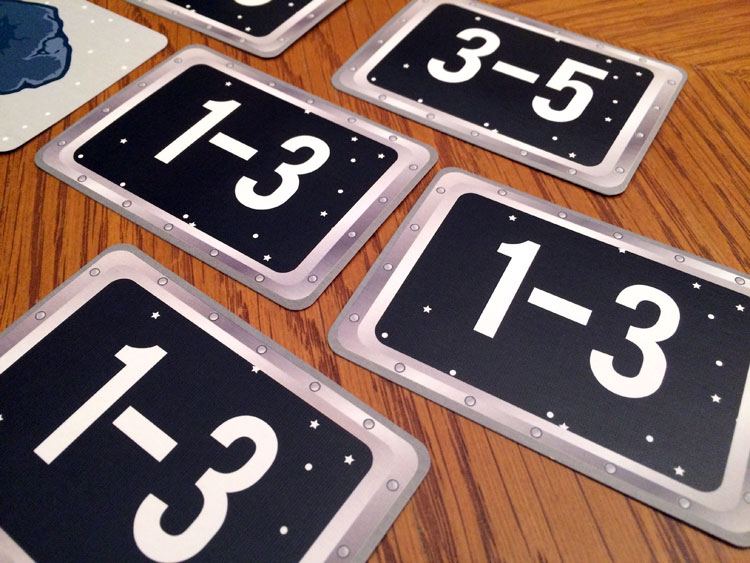
The artwork in the game has more of a cartoony style, which I feel works well in this game. It keeps with the overall light feel of the game, despite the impending doom.
I don’t think I have gotten a sand timer in a board game since I was a child, so I can’t speak to their quality but they seem to work just fine. I do have a few minor gripes about the iconography and the box for the game. Some of the iconography used on the meteor, tech and bonus/penalty cards are confusing. Even after a few times through the game, players will have to look at the rule book to make sure they fully understand what a card does before moving on with the game. I also find the box to be way too big for what is included in the game. With a game that only includes sand timers and cards, the box is about double the size you need and seems like a waste of space.
How to Play:
When setting up the game, the first thing to do is shuffle the collection of meteor cards together and place the required number of cards face down on the table. One player will be chosen as the timekeeper for the game. They will be in charge of managing the altitude zones cards and the sand timers during the game, with each timer representing one minute of real-time. Lastly players will receive a number of cards from the resource deck. This deck consists of a mix of energy, rocket, and technology cards that players will have at their disposal to win the game.
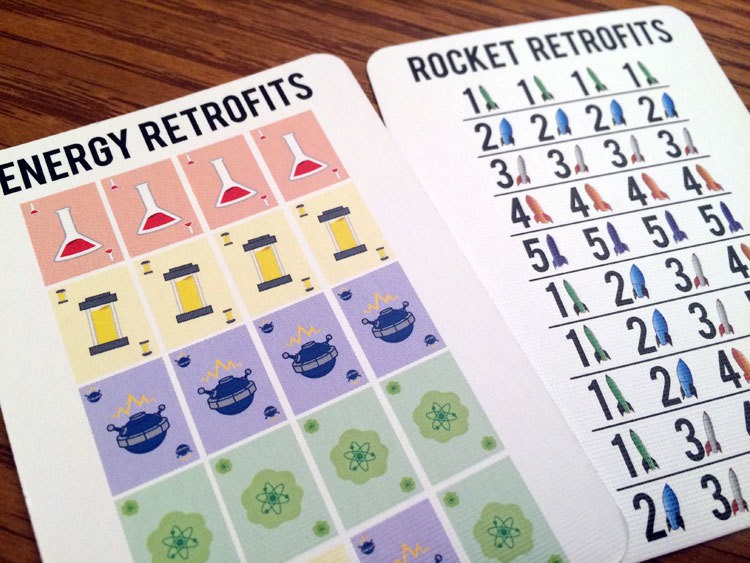
The number of launch sites is equal to the number of players in the game. Each player will be in charge of the launch site in front of them, but this is where the cooperative nature of the game comes through because anyone can start or assist in completing a project on the table. There are three types of projects a player can build while trying to save the world.
- Technology
Players will place a technology card on the table and if the team is able to complete it with the required energy cards, they are able to use that new piece of tech. These technology cards can allow players to talk, draw extra resource cards or to flip over all the meteor cards exposing their true size.
- Retrofit
Players can work at collecting the right set of four energy or rocket cards to draw at least one new card into each player’s hand.
- Rockets
Players will first place a rocket card into a launching site and, if they are able to have all the required energy, the rocket will hit the meteor of the player’s choosing. Rockets always do the amount of damage indicated on the card. If the meteor is being struck for the first time, the player will flip the card over and see if the rocket they fired will destroy it. If they are right on the number, the meteor is destroyed. But if the players are under the required number, nothing happens. Something interesting does happen when the damage you do is greater than the size of the meteor. The meteor is destroyed, but because of the overkill of force used causes the rest of the meteors to move closer to Earth. This forces a move immediately to the next altitude zone, which the timekeeper will administer.
As a reminder, this all has to be done without talking, but players can gesture, flash symbols, or anything else to get their point across. The timers start when players are ready and the game ends when all the meteors have been destroyed, or impacted with Earth, destroying the human populace.
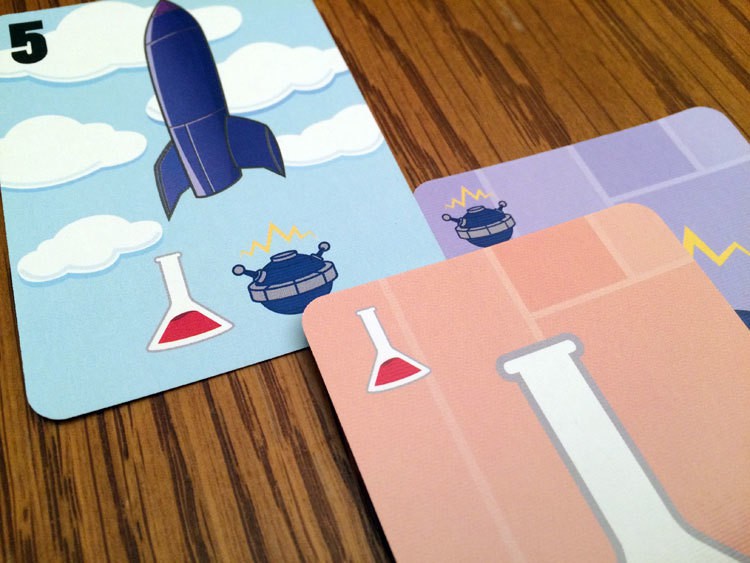
Game Experience:
There are two things that I look for in a real-time game, simplicity and chaos. Escape: Curse of the Temple is my favorite game that uses the real-time mechanic. The simple use of dice is easy to explain and it also has the mad dash of having to get back to the center tile while the soundtrack builds the tense atmosphere.
Meteor is certainly a chaotic game. Not being able to speak throws a huge monkey wrench into solving the problem the game presents. People have to rely on nonverbal communication to explain their plans and needs. Players will do a lot of pointing, grunting and unique facial expressions that will make you laugh a few times during the game. People might be turned off by this, but it adds a nice new element to a real-time game that requires you to stretch your communication skills.
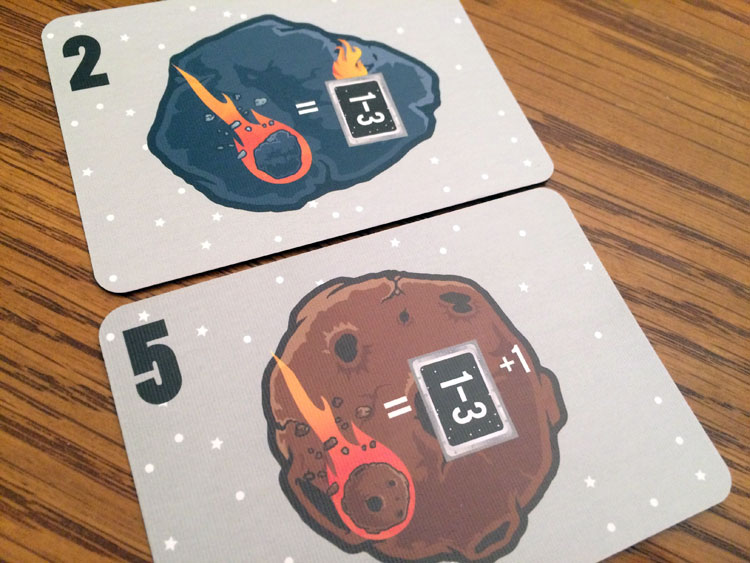
Despite not being able to talk to one another, you must find a way to work together to even have a chance. The game is not an easy one to win because you are never quite sure if you will get the necessary energy and rockets to stop the impending apocalypse.
Another thing that adds to the chaotic fun is the hidden values and traits of the meteor cards. There is a high sense of anxiety when you decide to fire that first rocket at a meteor card. Do you have enough power, maybe too much, or what secret trait does this meteor have? The highs and lows from this game comes from launching the rockets. Players will experience pure joy when you manage to take a meteor out with one shot and the dread of losing more time because the rocket’s power was excessive.
The hidden aspect of the meteor cards also hides the traits of a card. About half of the meteors have special rules associated with them that can require certain energy types, split into two smaller meteors, or even destroy other meteors of the same size around them but you won’t know these traits until you flip the card.
In terms of the second main component of a good real-time game, simplicity, Meteor is an easy game to learn how to play. Players quickly understand the premise of the game and will quickly adapt to the overall rules. Where the game loses this simplicity component is with the iconography on the cards. The energy and rocket cards are very easy to understand because, despite having no text, players can easily understand the rockets power and necessary energy cards to launch.
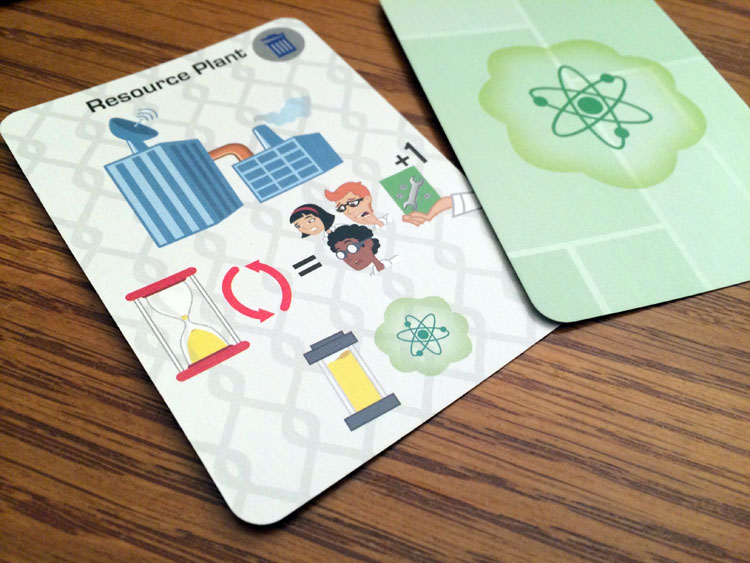
The issue is that the game tries to implement the same minimalist approach to meteor and technology cards and, for me, the pictures are not completely clear on what they are meant to represent. “What power does this grant?” and “What does this meteor do?” are going to be phrases you hear a lot as you play the game. I personally would have liked a small bit of text on the card explaining what they do. Even if you explain them before you start the game, players will still have questions, forcing you to stop the game to explain. This can happen in the most critical and heart pounding moments of the game and can take you out of the nail biting experience. Not a game breaker by any means, but it seems like something that could have been fixed. Luckily, the simplicity of the rest of the game easily makes up for any issues with these cards.
When I played the game I was always the timekeeper, the person responsible for turning over the sand timers. Unfortunately, this process isn’t elegant and can be rather clunky. It’s difficult to focus on both keeping the world for being destroyed and keeping an eye on the timers. I found that it works best if other players help out with the timers when they have completed turns for the segment. This allows for the timekeeper to enjoy the game more and keep the game on its five minute schedule. Maybe I’m just spoiled with the way other games handle this element, but I think there could’ve been a better solution with some sort of application for phones or tablets.
Each time you play, the meteors and resource cards are different, allowing for each game to feel just a little different from the others. There are more cards that you can add to the game, such as boss meteors, that have special abilities that activate when they are placed on the table or when destroyed. All of which are bad for the players.
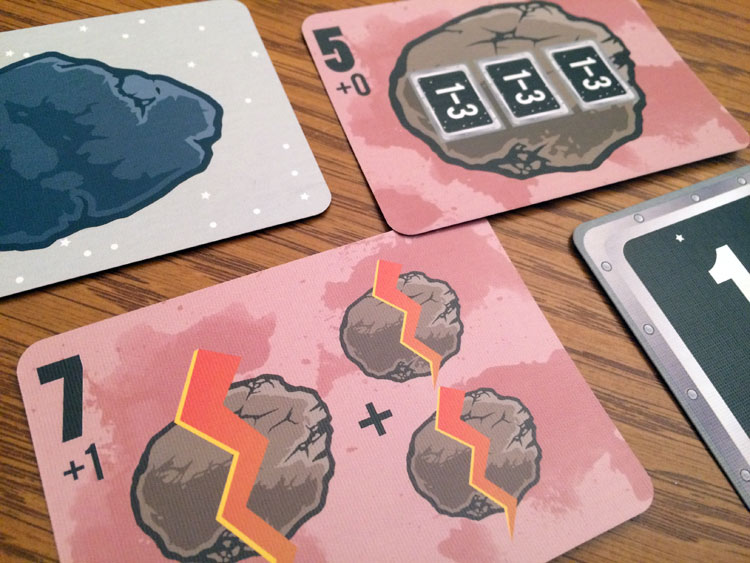
There are also power cards that can be used by the players to gain advantages during the game such as extra launch sites, drawing more cards, or giving rockets an extra boost of power. These you will really want to have when you start going against some of the boss meteors. However, if you start becoming a meteor destroying master, you can add challenge cards that make the game way more difficult to win by limiting what a player can do or adding new problems to solve. They all work very nicely together and add some new wrinkles that keep the game fresh each time you play it.
Final Thoughts:
I found Meteor to be a very enjoyable game. It fits nicely as a filler game to start off a gaming night. It has a good mix of simplicity and chaos, which is what I’m looking for in a real-time board game. Each game of Meteor is never the same and having additional cards that add new powers, boss meteors and new challenges gives the game a new feel for even the seasoned player.
The lack of verbal communication is not only an interesting mechanic, but it leads to some entertaining moments as you are trying to save the world. However, some of the iconography on the cards and less than perfect real-time elements break you from the intense nature of the game. The good thing is that these moments are few and far between, but keep this game from being truly great. This is a game that I will be happily keeping in my collection for when I feel like saving the world in no time at all. If you are looking for a real-time game to add to your collection make sure to consider Meteor.
If you’d like to get a copy of Meteor, you can pick it up for about $30.
Final Score: 3.5 Stars – A fast paced collaborative game that nicely weaves chaotic and simplicity into a 5 minute game.
 Hits:
Hits:
• Easy to explain
• Game is a new experience and challenge every time
• Unique game mechanics lead to some fun moments
Misses:
• Iconography isn’t as explanatory as it needs to be
• Box is oversized
• Running the time mechanism isn’t as clean as I would like.







